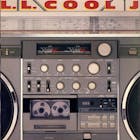features
Hip-Hop and the Boombox: A Loud Love Story
Hip-Hop and the Boombox: A Loud Love Story
Published Sun, July 28, 2024 at 10:00 AM EDT
It’s been referred to historically as the Ghetto Blaster, the Boombox and simply the Box, but despite what you prefer to call the portable radio, it’s been an integral part of Hip-Hop Culture since its inception.





Walkin’ down the street to the hardcore beat while my JVC vibrates the concrete”
- LL COOL J - ("I Can’t Live Without My Radio," 1985)





As we’re coolin’ on the block we carry our big box, playin’ LL’s 'Rock The Bells' or Run’s 'Rock Box...'”
- Stetsasonic – ("On Fire," 1986)

You’re walkin’ down the street with your Box in your hand and you’re playin’ the music of the poison clan...”
- The Crash Crew, ("Hi Power Rap," 1980)


D.J. Ross One’s “Wall of Boom” at Sotheby's auction house






